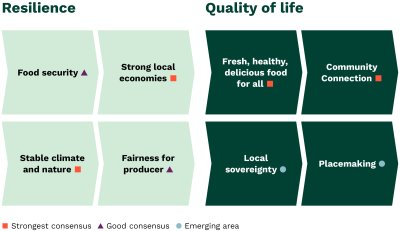At the start of the project in 2023, we set out to examine how the sector currently defines ‘local food’. This work is being used to inform the wider project, and was based on a review of pre-existing local food reports, case studies and academic papers.
As well as building on previous and ongoing work on local food led by others, we want to be sure that our approach and recommendations are grounded in the reality of local food systems in practice.
Between Autumn 23 to Spring 24, we interviewed 44 people working on the frontline of food. We spoke to farmers, wholesalers, retailers, buyers and many more across our four nations.
Our aim was to understand our collective vision for local food, the barriers presenting its growth and the solutions we need to see the sector thrive.
In our interviews, we explored participants' visions for a thriving local food system, their motivations for involvement, and their beliefs about the potential of local food. Responses varied, highlighting diverse potential benefits. However, the key themes were enhancing resilience, and improving quality of life.

In our interviews, we spoke with various practitioners working in infrastructure, retail, and procurement across the UK. Here's a snapshot of what we heard, out of the many barriers raised:
Key barriers:
Here is a snapshot of key solutions raised in our interviews, out of many possible solution. The next phase of the Local Food plan will work to explore these solutions and hear from other experts in the sector on which might have the biggest impact.
We'll be developing these solutions further with stakeholders across the country throughout 2024. To stay in the loop, sign up to our newsletter.
© Sustain 2025 Registered charity (no. 1018643) Data privacy & cookies